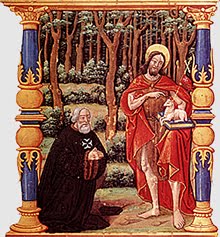As we approach the culmination of our Lenten journey, walking in our heart and our homes, with our Lord and God through the hills of Jerusalem, we are brought this year in a very real way to contemplate suffering – our own, and to make sense of it all, our Saviour's. We are grateful to our Chaplain Father Edward Corbould OSB for this paper.
A REFLECTION ON SUFFERING
Suffering sooner or later comes to all of us however much we might try to avoid it. It can embitter us or enrich us, with it we may grow as a person or we may diminish, it all really depends on how we respond to it. It can do many things for us: in the first place it can help to open us up to others in a way which very little else can. Suffering is intensely personal, we can only experience it in ourselves, we cannot experience it in others and so the wider our suffering the wider our knowledge of the suffering of others, and so the deeper can be our sympathy. It also opens us up to Christ because we can begin to understand what he suffered, not physically, although that of course is true, but through lack of success, of having the truth and yet being rejected, of being jeered at, of being deserted and let down by his friends. So suffering can bring us closer like nothing else to the person of Christ, for the personal love of Christ and trust in him are at the very center of our faith. Secondly, suffering can deepen and enrich us to see beyond the superficial and the transitory to that which is of eternal value. Put simply it can make us holy; it can transform us. Without suffering we can be like a greenhouse plant which lacks the strength to stand up to the first blast of cold air. St Paul uses the image of the athlete who submits himself to rigorous training if he is to win. These images stress in their own way that which is part of human wisdom, the law of life, that all development demands loss as well as gain, the narrowing of one part of life to achieve the broadening of the whole. No person develops towards maturity without renouncing pleasures, without suffering. the particular Christian contribution is that it is done for the overall motive of conforming us to Christ. We die with Christ in order to rise with him. We see in the Cross two aspects of suffering, the voluntary and the involuntary; but that was not a Christian invention. Suffering was there before. It is the Resurrection that is the Christian invention. It is the great solution to the mystery of suffering and the problem of pain.
Perhaps we can go off at a tangent for a moment. We live in a world in which human knowledge and human progress ate increasing at a rate which accelerates daily. Science and technology have obtained a massive prestige, faith is seen as superstition, wisdom and truth are words that philosophers in many countries prefer not to use; ends are suspect, guilt is psychological; physical well-being, standards of living, annihilation of suffering seem to be the ultimate goals, and the very mention of spiritual welfare is met by bewildered incomprehension. In such a world death, suffering, human frailty are the last bastions holding out against the advance of science; that is significant because they are the points at which we meet Christ and his Cross. Even in this scientific age, perhaps particularly in this scientific age, it is the Cross and its transformation in the Resurrection which alone make sense of life. The point is not an academic one of finding a solution to the mystery of suffering and the problem of pain but an urgent practical one of how we deal with suffering when we meet it. Like all really important things in life it depends on our own personal decision. Do we use suffering to bring ourselves closer to others and to Christ, to sympathize with them, to try to share their suffering, or to complain, to grumble and be resentful? In other words does in turn us in on ourselves or out of ourselves? Do we use suffering as a means for re-rooting our lives in Christ and his kingdom, or do we pine and cling to what is transitory and seems to be slipping out of our grasp? Let us pray that we may respond in a positive way to our suffering because that is the way to holiness, to happiness, to salvation. Jesus put it succinctly: ‘He who does not take up his cross and follow me is not worthy of me. He who finds his life will lose it and he who loses his life for my sake will find it’. (Matthew 10:38-39)
Our Lady of Sorrows, pray for us.
Our Lady of Sorrows, pray for us.
Our Lady of Sorrows, pray for us.
(The image is from the Pietà by Justin-Chrysostome Samson at Corpus Christi Maiden Lane)
COMMENTS: Exceptionally this Holy Week, since we are physically separated by our imposed isolation, we shall enable Reader Comments for these meditations, for those who wish to engage in a fruitful spiritual exchange of thoughts. If this is abused, by silly or offensive people, we shall disable them, to the detriment of many.

























